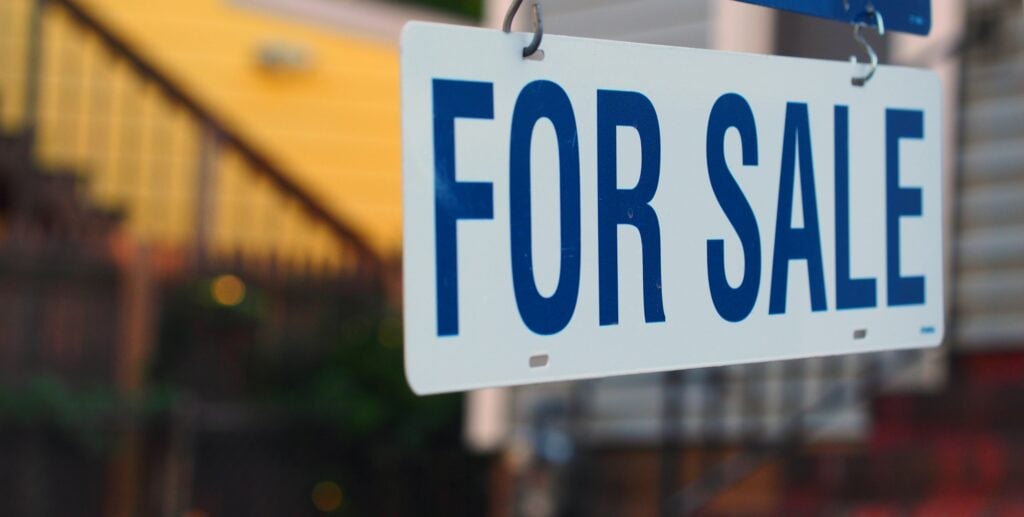Let’s set the scene for the average American homeowner: The year is 2019, and our perfectly average (or, more specifically, median) American homebuyer—who we will call Average Joe—purchases his first home. Average Joe pays $258,000 (the median U.S. home price in 2019). He uses an FHA mortgage and puts 5% down.
And, as we all know, the next few years are crazy. The market absolutely explodes, and by September 2021, Joe’s property is worth an astonishing $395,000—a 53% increase in value in 18 months. Joe’s $12,500 down payment is now worth close to $137,500 in home equity.
But wait: It gets better. Joe used a 4% interest rate mortgage when he bought his home. Between principal, interest, taxes, insurance, and private mortgage insurance, Joe’s monthly payment in 2019 was $1,687 per month.
By late 2021, average mortgage interest rates had fallen to 2.75%. Between the huge appreciation and low interest rates, Joe makes the average, obvious decision: He refinances his home mortgage.
His lender continues to pile on with the good news. Because Joe’s home value is now $395,000, he can get a new mortgage of $297,000, or roughly 25% of his home’s value. As his current mortgage balance is $245,000, this puts a cool $52,000 in cash into Joe’s pocket.
And because the interest rate is lower, and he is able to refinance out of his FHA mortgage with PMI, his mortgage payment drops from $1,687 per month to $1,595 per month.
At the end of this extraordinary—yet average/median—sequence of events, Joe has:
- $52,000 in his pocket
- $100,000 in home equity
- A $297,000 home mortgage fixed for 30 years at 2.75%
The average decision to finance at low rates occurred to the tune of $8 trillion in mortgage origination volume, mostly through refinancing, in 2020 and 2021, across tens of millions of individual mortgages. Nearly all of these were fixed-rate mortgage refinancings. This means tens of millions of Americans are in Average Joe’s shoes.
Picking up our story in 2024, Average Joe has more money and a lower payment than he could have possibly hoped for. But this incredible sequence of events has led to a new, “good” problem for Joe and tens of millions of Americans like him: Joe is stuck, or “locked in.”
If Joe sells his house and purchases it again (or a house in a similar neighborhood at the same price point, closer to his new job) with a new mortgage, at today’s rates, his payment would increase to $2,396 per month. Average Joe, like most Americans, would not be able to sustain his current lifestyle and cover this $700 per month increase in cash outlay. It would take a true disaster or major opportunity at work to uproot Joe.
And yet, people do have disasters, opportunities, and personal commitments they need to honor. Regardless of the pain involved in terms of skyrocketing costs or voluntary reduction in the standard of living, many Americans do, and will, encounter death, disease, divorce, or disaster, or have a career or personal commitment that requires them to move, even away from their incredible low-rate mortgage.
At some point, Average Joe, like most Americans, will have to move or want to move badly enough that the financial pain of relocating, in terms of quality-of-life reduction or steep rises in his monthly mortgage payment, will be overridden. And when he does move, he will be faced with a decision that may make or break his financial future:
Should he sell his home or keep it as a rental?
The answer, to me, is clear. Average Joe, as described in this example, should keep it as a rental. I spent a great deal of time mapping this out, running the numbers, making thoughtful assumptions, and considering alternative investments that Joe could make with the equity in his home. The following case study and model I constructed will illustrate my argument.
Case Study 1: Median American Homeowners Should Keep and Rent, Not Sell, Their Primary Residence
Case 1A: Joe sells the property – Key Assumptions:
- Joe has a home worth $415,000. (It appreciated a bit more since he last refinanced.)
- Joe has a remaining mortgage balance of $279,000, at 2.85% interest, with 27.5 years to go.
- His payment, including taxes and insurance, is $1,595 per month.
- If he sells the property, after 7.5% all-in transaction expenses, he will net $105,000.
- He can use this $105,000 to do one of two things:
- Put it toward his new home and reduce the mortgage balance/payment accordingly, reducing a mortgage that charges 7.5% interest.
- Put it in the stock market, in an S&P 500 index fund, earning an average of 10% per year.
Case 1B: Joe keeps the property – Key Assumptions:
- All the mortgage assumptions stay the same.
- Joe rents his home for $2,600 per month.
- Joe has $530 per month in maintenance, capital expenditures, and vacancy allowance costs.
- His home, rents, and expenses will all grow in line with inflation at a rate of 3.4% per year, compounding.
- For management, Joe can either:
- Do it himself and earn $475 per month.
- Hire a property manager, and after a 10% rental management fee, take home $215 per month instead.
Coincidentally, BiggerPockets can help Joe with whatever route he chooses to take. Quick Plug:
- We have excellent local Agents to help him evaluate the property and make assumptions about sale price, and of course sell the property. Free to use.
- We have peer-reviewed Property Managers to help him outsource management. Free to use.
- We have a Pro Membership for $390 per year that includes:
And that’s just where Pro Starts. If Joe gets serious about expanding his investing, he can also use the included Market Finder, Deal Finder, Deal Analysis Calculators, and access a huge library of advanced content in our Resource Hub.
Of course, Joe can also use free stuff on BiggerPockets, like the spreadsheet powering this case study and the BiggerPockets forums. Those forums are a great catch-all for all of the weird outlier scenarios that can pop up in the tenant/landlord relationship.
Okay, back to the case study.
If Joe has beef with any of these assumptions or wants to modify the study for his purposes, he can download the free spreadsheet I created, putting in details about his current situation and assumptions that are better than the ones I make. The spreadsheet/calculator tool can be found here and is accessible to anyone with a free BiggerPockets membership.
What to Consider
It’s no contest. Joe will be way richer under this set of what I believe to be fairly reasonable assumptions by keeping his property as a rental. He will produce more cash flow, whether he manages the property himself or hires out management than the alternatives. And he will generate way more net worth in both the near and long term.

In 10 years, keeping the property will create $200,000 more net worth for Joe than selling and investing in index funds. In 30 years, that number compounds to nearly $1.3 million more. And that’s if Joe hires out management to a competent property manager and doesn’t have to pick up the phone and deal with tenants and toilets at 2 a.m.

Joe can juice his returns even more by handling property management himself, adding another cool $1.3 million to his long-term net worth if he is willing to self-manage.
I understand that many Americans do not want to manage property or deal with the risks and headaches of rental property investing. It is work and a headache.
That said, many Americans also like the idea of retiring from a lifetime of work, as well as all the toys that $1 million to $2.5 million in incremental wealth can buy. I don’t like the work that sometimes comes along with rental property investing, but I do like the millions of dollars in wealth it can create over a few decades relative to alternatives.
The massive size of this decision needs to be weighted appropriately in context. Too frequently, homeowners just don’t want “the hassle” of a rental property.
But when that hassle has a reasonable chance to result in wealth equivalent to a lifetime of earning and saving a wage, is it really a “hassle”?
At the very least, homeowners should run the numbers and understand exactly what they are likely giving up by selling. Please, stare down the $2.5M in opportunity cost before making an irreversible decision.
Once it’s gone, you can’t go back and get that juicy 3% interest rate.
Case Study 2: A $1 Million Lightly Levered Home Should Be Sold, Not Kept
If we throw out Average Joe and replace him with a higher net worth family in a much larger and more lightly levered home, the math changes and the decision is likely to change in favor of selling the home.
This case study is likely more specifically applicable to members of the BiggerPockets community, who tend to be wealthier, have higher incomes, and have more expensive primary residences than median Americans.
Here is a new set of assumptions:
Case 2A: Million-dollar home sale
- Home is worth $1 million.
- There’s a remaining mortgage balance of $421,000, at 2.85% interest, with 27.5 years to go.
- The payment, including taxes and insurance, is $2,861 per month.
- A sale, after 7.5% all-in transaction expenses, will net $503,000 in proceeds with no tax impact.
This $503,000 can be used to do one of two things:
- Put it toward a new home, reducing a mortgage that charges 7.5% interest.
- Put it in the stock market, in an S&P 500 index fund, earning an average of 10% per year.
Case 2B: Keep the million-dollar home
- All the mortgage assumptions stay the same.
- This home rents for $3,800 per month.
- The homeowner has $790 per month in maintenance, capital expenditures, and vacancy allowance costs.
- The home, rents, and expenses will all grow in line with inflation at a rate of 3.4% per year, compounding.
- With DIY management, the property cash flows $149 per month.
- With outsourced property management, the property negatively cash flows by $231 per month.
Here are the results:


With the same long-term expectations for rent growth, appreciation, and stock market returns, our model tells us that the million-dollar homeowner in this scenario would give up a lot of wealth to keep their home instead of putting the proceeds towards alternative uses.
To me, in this situation, what stands out is the huge difference in annual cash flow that just paying off the mortgage on the next home purchase makes at a 7.5% interest rate. If I were this million-dollar homeowner, I’d be heavily tempted to reduce my next home mortgage payment (if I were dead set on owning my next home—renting is a great alternative for many in this situation) as much as possible rather than invest in alternatives.
It’s an easier life for about 30 years, in terms of the demands on the household for realized income generation, and only a relatively modest 15-20% opportunity cost in terms of long-term net worth compared with investing the proceeds in the stock market at 10%. This opportunity cost decreases if one is more skeptical or conservative about long-term market returns from stocks.
Some Tax and Transaction Cost Thoughts:
Many readers who are familiar with real estate investing and primary residences will be asking questions about the tax impact of selling a primary residence. Thanks to a special IRS tax loophole, homeowners can exclude $250,000 to $500,000 of capital gains from the sale of a primary residence, so long as they have lived in the property for two out of the prior five years.
The model I built factors in this consideration with a toggle for both federal and state-level capital gains taxes, and the base case assumes that capital gains taxes do not apply to someone selling in the first three years after they move out of the property.
Zooming in on the net worth impact in the early years for Average Joe, this tax advantage has the following effect on post-tax wealth:

I use a concept I call “realizable equity” to compute “net worth” in each scenario involving property, which considers the spendable liquidity that would come into the seller’s life after transaction costs and tax considerations.
I believe that this is the most conservative way possible to compute the “net worth” that a property brings into someone’s life.
Notably, I do not compute stock portfolio net worth after taxes if/when stock holdings are realized. And, notably, a real estate investor with a long-term rental has many options to have a better tax outcome when they do decide to liquidate the property, including the 1031 exchange.
Thus, the true wealth differences between stock and real estate are understated for Average Joe. The true, after-tax, apples-to-apples considerations would likely result in Average Joe having an even better after-tax financial picture than what was modeled above when holding his property and superior tax options to stocks held and growing in an after-tax brokerage account.
Final Thoughts
Most American homeowners aren’t moving anytime soon. The lock-in effect is real, and unless someone has personal or career circumstances that compel them to move, they are likely to stay put as long as possible.
However, there will inevitably be a gradually accelerating flow of people who do have to move, and many of them can make a choice about whether to keep or sell their current home. A huge percentage of these people could be better off by a lot if they keep their homes as rentals rather than sell them when it’s time to move.
I implore those reading this to do the math. Make decisions based on what you believe, after running the numbers and testing your assumptions, and understand that, even if you don’t like the idea of being a landlord and rental property investor, the millions of dollars lost in opportunity cost from choosing not to keep your home may convince you to change your tune.
I believe that this free spreadsheet, pre-populated with Average Joe’s assumptions, is the best tool available right now in making this decision. You can run the numbers yourself, make the decision to sell or keep, and compare it across the four most likely scenarios a typical homeowner is likely to encounter.
This may be the biggest financial decision millions of Americans make in the coming years. It would be a shame if a huge percentage of them made it without thinking it all the way through and running those numbers.
Please let me know what you think about my analysis, spreadsheet (which you can download for free here), and write-up in the comments. I look forward to hearing from you, and the inevitable debate I will get from very thoughtful and sharp commenters.
Ready to succeed in real estate investing? Create a free BiggerPockets account to learn about investment strategies; ask questions and get answers from our community of +2 million members; connect with investor-friendly agents; and so much more.
Note By BiggerPockets: These are opinions written by the author and do not necessarily represent the opinions of BiggerPockets.




